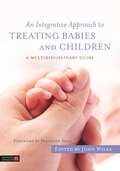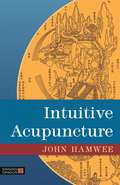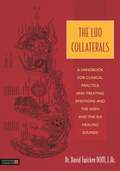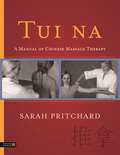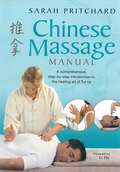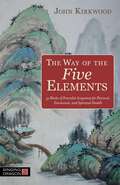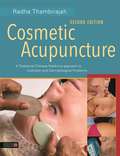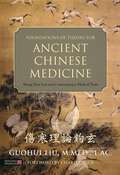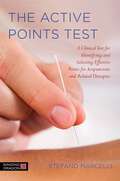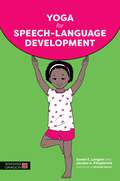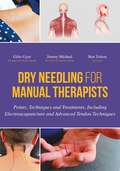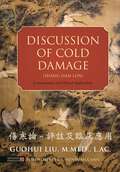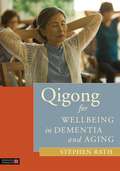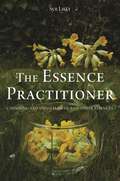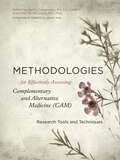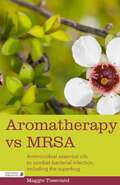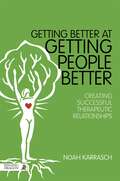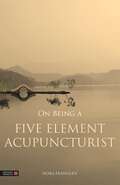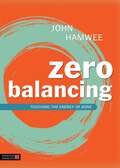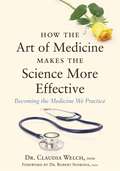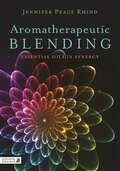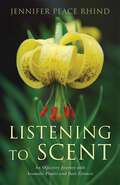- Table View
- List View
An Integrative Approach to Treating Babies and Children: A Multidisciplinary Guide
by Michael Shea Franklyn Sills Ann Diamond Weinstein John Wilks Anita Hegerty David Haas Dr Carolyn Goh Graham Kennedy Matthew Appleton Professor Franz Ruppert Thomas HarmsWorking with babies and children is most successful when therapists have a complete understanding and overview of all appropriate treatment options, and the effects of early influences on child health and development. This book shows therapists how to consider these factors in order to work more effectively within their individual areas of expertise. Contributors from a wide range of disciplines explore the influence of pregnancy, birth and family dynamics on the physical and mental health of babies and children. They show how these factors relate to common complaints, such as excessive and different types of crying, chronic illnesses and poor immune systems, and behavioural and attachment issues, and how complementary approaches can be best applied to treat these issues. This book also offers helpful advice for working within multidisciplinary teams. Illustrated with case studies and including examples from current research, this book is a valuable resource for therapists from diverse disciplines.
Aromatherapy, Massage and Relaxation in Cancer Care: An Integrative Resource for Practitioners
by Graeme Donald Timothy Jackson Dr Jacqui Stringer Paula Maycock Reverend Kevin Dunn Lydia Nightingale Debs Costello Gwynneth Campbell Lynne Tomlinson Anita Mehrez Anne Cawthorn Dr Peter Mackereth Rebecca Knowles Ann CarterAromatherapy, massage and relaxation are three of the most commonly used therapies in cancer care. This book offers an integrated approach to using these therapies and provides an evidence-based foundation for complementary therapists working in cancer care settings. International in its scope, the book provides essential information about the ethical and professional context in which therapists can practice and vital facts regarding medical treatment and potential side effects.
Face to Face with the Face: Working with the Face and the Cranial Nerves through Cranio-Sacral Integration
by Thomas Attlee R.C.S.T. Dr Granville Orthodontist L. D. S. R. C. S. E Lond Dr Wojciech TarnowskiPractical and clear, this comprehensive guide to cranio-sacral treatment of the face explains treatment approaches that can make a significant difference to persistent and intractable conditions, enabling profound transformation in quality of life through whole-person integration. The book explores the eyes, ears, nose, sinuses, mouth, teeth and jaw, and provides a practical means of resolving the multitude of conditions affecting these crucial areas in a gentle, non-invasive manner, utilising the body's inherent healing potential. It covers a wide range from persistent ear infections, dental disturbances, facial injury, sinusitis and trigeminal neuralgia, one of the most painful conditions known to the medical world, through to identifying hidden causes of migraine, autism and chronic fatigue and patterns of ill health arising from birth, early childhood and past trauma. Cranial nerve dysfunctions, including polyvagal disturbances, are also included. Hand positions and contacts are clearly presented with over 200 colour photographs and anatomical drawings. A comprehensive presentation of the potential cooperation between dentistry and cranio-sacral therapy is also provided, with contributions from two eminent dentists, providing much needed information on this growing field of integrative medicine. Essential reading in this rapidly expanding area of practice, the book is fully illustrated in colour.
Intuitive Acupuncture
by John HamweeThe role of intuition is seldom identified in acupuncture training as one of the keys to effective practice. John Hamwee here explores its paramount importance in diagnosis and treatment, showing how development of the intuitive sense, and its appropriate use in the treatment room, is vital to building the most effective individual practice. Through discussion of theory, clinical example, and the experiences of leading acupuncturists, the author shows how intuition, or the grasping of subliminal clues, can be developed, based on the practitioner's growing `storeroom' of clinical experience and why it is so useful for this to become a conscious and rigorously examined process. He discusses the process of testing intuition against objective observation of the patient, and how an intuitive leap can provide a shortcut across an innumerable series of diagnostic steps, and lead to diagnostic and treatment decisions that make complete sense of the observable phenomena. He suggests that learning to trust the intuitive faculty, while still fully interrogating conclusions, is the basis of better patient outcomes and significantly advanced practice. This thoughtful and engaging book will be one that acupuncturists will want to read and reread, and will speak to all therapists, counsellors, and health practitioners.
The Luo Collaterals: A Handbook for Clinical Practice and Treating Emotions and the Shen and The Six Healing Sounds
by David TwickenFirst referenced in the Ling Shu and the Su Wen, the Luo Collaterals or Luo Mai, are an integral part of the acupuncture channel system. In this book, Dr. David Twicken provides a comprehensive account of the Luo Mai, including detailed analyses of the classical and contemporary theories and clinical applications. Modern practitioners often use the Luo Collaterals to treat the emotions and the organs, with treatments influencing the blood network, especially the veins and capillaries, along the Luo pathways. Dr. Twicken presents a thorough historical analysis of the new theories on which our modern understanding of the Luo Collaterals and Luo points is based, and explains the applications. He explores the classical Chinese medical and Taoist interpretation of the Shen, the five Shen and the emotions and provides a comprehensive historical analysis of the Window of the Sky points. Dr. Twicken also includes instruction on Healing Sounds Qigong, one of the oldest and most effective forms used to treat the emotions, the internal organs and the five Shen. An accessible and authoritative guide to the Luo Collaterals, this book will be of immense value to students and practitioners of acupuncture and Chinese medicine, Taiji and Qigong practitioners; and anyone with an interest in Taoist practice.
Tui na: A Manual of Chinese Massage Therapy
by Sarah PritchardTui na: The Chinese Massage Manual is a comprehensive and well established handbook for students and practitioners of Tui na in the West. The author describes the roots and development of Tui na, how it works therapeutically with the context of Chinse medicine, and how to become an effective Tui na practitioner. The book contains detailed and clearly illustrated descriptions of Tui na techniques, how to practice them, their clinical applications and therapeutic effects. Foundation area routines are provided to support the development and fluidity of manual skills and to give an initial structure for building treatments. The book has a unique approach to creating and planning Tui na treatments. Avoiding the prescriptive approach usually employed, the author discusses the principles of practice and enables the student practitioner to make choices and formulate treatments by bringing together their knowledge and skills. Frameworks are provided, and techniques, methods and approaches suggested for presenting patterns of disharmony within the treatment of common ailments. The book features - Over 120 photographs clearly illustrating the techniques - THe application of the ancillary therapies of cupping, gua sha and moxibustion - The application of external herbal media - `Tips for Practice' easy reference to support the learning of techniques - Case histories illustrating the treatment of common clinical ailments - Treatment foundation area routines - Yin and yang styles of practice - Demonstration of how to combine Tui na and acupuncture in practice - a related series of videos (available online) showing how to apply all the major techniques
Tui na: A Manual of Chinese Massage Therapy
by Sarah PritchardTui na: The Chinese Massage Manual is a comprehensive and well established handbook for students and practitioners of Tui na in the West. The author describes the roots and development of Tui na, how it works therapeutically with the context of Chinse medicine, and how to become an effective Tui na practitioner. The book contains detailed and clearly illustrated descriptions of Tui na techniques, how to practice them, their clinical applications and therapeutic effects. Foundation area routines are provided to support the development and fluidity of manual skills and to give an initial structure for building treatments.The book has a unique approach to creating and planning Tui na treatments. Avoiding the prescriptive approach usually employed, the author discusses the principles of practice and enables the student practitioner to make choices and formulate treatments by bringing together their knowledge and skills. Frameworks are provided, and techniques, methods and approaches suggested for presenting patterns of disharmony within the treatment of common ailments.The book features- Over 120 photographs clearly illustrating the techniques- THe application of the ancillary therapies of cupping, gua sha and moxibustion- The application of external herbal media- `Tips for Practice' easy reference to support the learning of techniques- Case histories illustrating the treatment of common clinical ailments- Treatment foundation area routines- Yin and yang styles of practice- Demonstration of how to combine Tui na and acupuncture in practice- a related series of videos (available online) showing how to apply all the major techniques
Chinese Massage Manual: A comprehensive, step-by-step introduction to the healing art of Tui na
by Sarah Pritchard Li HeThis comprehensive, introductory book covers the essentials of Chinese massage (Tui na), including the fundamental principles of Chinese medicine, and the 20 basic massage techniques. It also includes treatment advice for 12 common ailments, so that the reader can practice what he or she has learnt to good effect. The book covers: · Instruction on 20 specialized massage techniques · How to locate over 50 points to treat specific problems · How to combine massage with Qi Gong for maximum energy and wellbeing · Step-by-step treatments for common colds, lower back pain, sciatica and more · Clear photographs, diagrams and charts The author provides key information in clear, easy to refer to tables and diagrams, making this also an excellent reference for students, and practitioners of related disciplines.
The Way of the Five Elements: 52 weeks of powerful acupoints for physical, emotional, and spiritual health
by John KirkwoodFramed within the context of the modern, everyday world, this book takes a refreshing, anecdotal stroll through the healing principles of Chinese medicine, looking at key acupoints for each week of the year. The author journeys through the seasons of the Five Elements and within them the physical, emotional and spiritual associations of key acupoints, exploring their names, functions, and intensely practical healing use in the real world. The acupoints range from the point that can help with your sense of smell, through to the Fire points that can help with a good sense of humour. With clear descriptions and images that express the spirit of the season, and photographs of the point locations, this book is perfect for anyone interested in a different view of the body and its healing relation to the seasons, as well as students and practitioners of Chinese medicine looking for deep and memorable insight into their work.
Cosmetic Acupuncture, Second Edition: A Traditional Chinese Medicine Approach to Cosmetic and Dermatological Problems
by Radha ThambirajahA guide to the diagnosis and treatment of cosmetic and dermatological problems with practical instruction on how to perform treatment techniques. Thambirajah explains the energetic imbalances which cause skin diseases and the problems of early ageing, and describes how they can be treated successfully. Skin problems occur because the Blood, Qi, yin and yang of the body are not in balance and the book discusses how these can be balanced by acupuncture therapy. The therapy for a cosmetic problem has three steps: 1) to balance the body energies that cause the problem, 2) to treat the problem locally, 3) changing the diet and lifestyle of the patients with these problems. Concepts are accompanied with useful illustrations throughout, demonstrating the methods described. This second edition also contains new material on needling and massage techniques. This is a comprehensive and authoritative textbook on the topic for practising acupuncturists and Chinese Medicine practitioners.
Foundations of Theory for Ancient Chinese Medicine: Shang Han Lun and Contemporary Medical Texts
by Charles Buck Guohui LiuDiscussion of Cold Damage (Shang Han Lun) and contemporary texts of ancient China form the bedrock of modern Chinese medicine practice, yet these classic texts contain many concepts that are either hard to understand or confusing. Based on over thirty years' medical practice, and study of the texts, this book explains the concepts involved so that the clinical applications of the ancient texts can be better understood and put into practice. The author looks at the larger context of ancient Chinese culture and philosophy in terms of theoretical knowledge, scholarly approach, and mindset in order to explain the basis for the medical texts. He also discusses the work of later Chinese medical scholars in elucidating the texts. He then goes on to look at more specific issues, such as the six conformations, zang-fu organ theory, the theory of qi and blood, the theory of qi transformation, and how these are understood in the ancient texts. He also discusses shao yang and tai yang theory; the element of time, and its place in understanding six conformations diseases. This remarkable work of scholarship will clarify many questions about the interpretation of the ancient texts for modern use, and will find a place on the bookshelf of every practitioner of Chinese medicine, as well as on those of scholars of Chinese medicine.
The Active Points Test: A Clinical Test for Identifying and Selecting Effective Points for Acupuncture and Related Therapies
by Stefano MarcelliThe Active Points Test is a clinical instrument for identifying and selecting the points on the skin that are most effective for treatment. These points may be close to the seat of the disease, for example on the shoulder for periarthritis, or far away, for example on the ear or head for stomach pain or a cough. Drawing on principles from TCM and Western medicine, Dr Stefano Marcelli sets out the theory of the approach and offers detailed guidance on how to carry out the test and how to interpret the results, as well as explaining how the test can be used in different therapies. The test is based on the discovery that a patient experiencing an ongoing symptom can be made aware of the capacity of a few points on the skin to treat his or her discomfort. The test involves stimulating the skin to the appropriate degree whilst asking the patient to identify whether there is any change in the symptom he or she is suffering, and can be used to treat a wide range of symptoms, from articular pain to migraine, tachycardia, asthenia and depression. Published for the first time in 1995, this substantially updated edition contains the most recent supporting evidence and many new explanatory diagrams and photographs. Providing a comprehensive and effective system for point selection, this is essential reading for practitioners and students of acupuncture and related reflex and manual therapies, including massage, tuina, Shiatsu and Rolfing.
Yoga for Speech-Language Development
by Jessica A. Fitzpatrick Michelle Mozes Susan E. LongtinCombining years of experience as certified speech-language pathologists and as qualified yoga teachers, the authors of this pioneering book explain how yoga can be used to aid speech-language development in children up to age 12. The book includes a range of yoga-based exercises for improving pre-linguistic communication, vocabulary development and motor planning for speech. The text is enriched by illustrations of children in each yoga pose, so no prior experience of yoga is necessary to help children carry out each activity. The book also provides information on using this approach with children with neurodevelopmental and intellectual disabilities, including ADHD and autism.
Dry Needling for Manual Therapists: Points, Techniques and Treatments, Including Electroacupuncture and Advanced Tendon Techniques
by Giles Gyer Jimmy Michael Ben TolsonDesigned to be a go-to reference for assessment and treatment planning in the clinic, this is a clear and concise handbook for students and practitioners of dry needling, or medical acupuncture. It includes: · Comprehensive medical illustrations demonstrating trigger point locations and associated pain referral patterns · Easy-to-follow instructions and photographs demonstrating musculoskeletal dry needling points and electroacupuncture techniques · Dedicated section on the acupuncture treatment of tendinopathy · Vital information on palpation and correct needling techniques · Practical guidance on best practice, safety and treatment planning · Overviews of the history and key principles of Traditional Chinese medicine and acupuncture · Up-to-date research on the effect of acupuncture in the treatment of MSK conditions, myofascial pain, trigger points (MTrPS), fascia and pain. The book will be an essential aid for osteopaths, physiotherapists, sports rehabilitators, chiropractors, massage therapists, as well as traditional acupuncturists wishing to understand a Western approach on acupuncture. Other health professionals incorporating, or looking to incorporate dry needling into their treatment programme, will also find this book an invaluable resource.
Discussion of Cold Damage (Shang Han Lun): Commentaries and Clinical Applications
by Henry Mccann Guohui LiuA major new translation of the Chinese classic Shang Han Lun by scholar and medical doctor Guohui Liu makes this foundational text fully accessible to English speaking clinicians for the first time. Extensive study and research underpins the translation; the author's understanding of both classical and modern Chinese enables him to interpret fully the ancient work within the theory of Chinese medicine. An extensive commentary explains the translation, the difficulties with the text, how it has been subsequently translated and expands on the theory laid out in the original text to reach an understanding that can be applied in the clinic for diagnosis and treatment. The value of this classic text lies primarily in its establishment of a basic framework for differentiation and treatment, but it also presents 112 formulas and 88 medicinal substances, which are commonly applied in clinical work for various conditions. In this edition, the 112 formulas are fully explained in the context of the clinical experiences of well-known ancient and modern doctors, and they are also laid out in two appendices, cross referenced to the text.
Qigong for Wellbeing in Dementia and Aging
by Laurha Frankfort The Natural Healing Research Foundation Stephen RathQigong is the centuries-old practice of moving vital energy (Qi) through the channels of the body, known as meridians, to promote vitality and health. Stephen Rath details current research and Traditional Chinese Medicine theory to show how Qigong practice can support cognitive functioning, as well as emotional and physical wellbeing, in people with dementia. Qigong for Wellbeing in Dementia and Aging presents a set of accessible Qigong exercises and breathing techniques adapted specifically for older people who may be frail or have limited mobility, which address specific symptoms associated with dementia. These include exercises for the hands and feet, exercises for releasing emotions through the Five Animal Sounds, seated exercises, and facial exercises. The exercises, contributed by the Natural Healing Research Foundation from their Senior Exercise Class in Hawaii, are presented with clear explanatory illustrations. The final part of the book describes the Chinese understanding of nutrition as an essential underpinning of good health into old age, and provides health-giving food and drink recipes for people with dementia based on these principles. There is also a helpful chapter on practicing Qigong to protect against caregiver burnout. This will be an invaluable book for care professionals, nurses, activity coordinators, and physical therapists, as well as people with dementia and their families.
The Essence Practitioner: Choosing and using flower and other essences
by Tony Pinkus Sue LillyThis practical handbook covers everything you need to know to use flower and other essences effectively with clients. Sue Lilly explains what is happening energetically when essences are at work and draws on her wealth of essence knowledge to provide guidelines on: · Assessing - techniques for testing clients · Choosing - how to select appropriate essences for a range of conditions · Using - new and innovative applications of essences · Creating - different methods of creating essences and guidelines for selling them · Expanding knowledge - how essences can be linked to chakras, meridians and subtle bodies and how this knowledge can enhance practice This comprehensive guide is ideal for any student starting out or any practitioner wanting to explore new ways of using essences.
Methodologies for Effectively Assessing Complementary and Alternative Medicine (CAM): Research Tools and Techniques
by Ba Dc Shahar Lev-Ari Alison Trewhel Paul Lam Rhayun Song Peter W. Mccarthy Kevin W. Chen Katie Thirlaway Robert T. Mathie Sukhee Ahn Peter Herbert Andrew Flower Narendra S. Bhatt Beverly L. Roberts Liat Edry-Botzer Nicola Robinson Fan Qu Philip Harris Landis M.F. Vance Kenneth A. Leight Paul Kadetz Dr Megan Arroll Mariann Sisco Sefore Conti Akiva Vexler Mark J. Langweiler DaapmFinding the right criteria to use when judging Complementary and Alternative Medicine (CAM) is essential if it is to stand up to criticism from those concerned about the importance of evidence-based medicine. This edited volume highlights how CAM requires different research tools and techniques from conventional medicine, and examines effective methodologies for accurately assessing CAM. Addressing a problem which is often cited as the reason for a failure to appreciate the potential in CAM approaches to patient care, experts from a wide array of CAM modalities suggest the most effective research methodology for each particular therapy and illustrate how a lack of adherence to that methodology produces a less effective assessment. Disciplines covered include Traditional Chinese Medicine, homeopathy, herbal medicine, craniosacral therapy, qigong and yoga. Providing direction in research and the best criteria to appropriately assess each discipline, this book highlights and responds to the issues underlying research in CAM. It will be of interest to anyone involved in CAM research, in addition to CAM practitioners and students, western medical practitioners looking to include CAM in their treatments, and anyone studying research design and methodology.
Aromatherapy vs MRSA: Antimicrobial essential oils to combat bacterial infection, including the superbug
by Maggie TisserandAddressing the challenge of serious infection, especially MRSA, in hospitals, in the community, and in animals, Maggie Tisserand focuses on the scientifically proven effects of antibacterial essential oils, and their usefulness in managing infection, including the 'superbug'. She profiles the key essential oils - tea tree, manuka and thyme - covering everything from habitat, chemistry and commercial uses to the latest scientific research that proves their effectiveness against bacterial infection, and how they should be used. She also includes information about other methods that have been shown to help with the management of acute infection, including allicin from garlic, silver, manuka honey and phage therapy. Breaking new ground in the field of essential oils, this scientifically based but accessible book will be essential reading for aromatherapists, health professionals and everyone interested in effective ways in which to combat infection and stay healthy. With the increase in antibiotic-resistant bacteria and the danger of bacteria staying alive on surfaces and clothing, it is in the interests of every therapist and practitioner to be aware of these threats and instigate preventative measures.
Getting Better at Getting People Better: Creating Successful Therapeutic Relationships
by Noah KarraschWhat is it that really gets people better? With practical information on how to support clients' healing processes, this book helps practitioners across a wide range of physical and medical therapies, as well as psychotherapists, to improve their practice and get better at what they do. Getting to the core of true healing, Noah Karrasch explores the essentials of effective practice that apply across all healing modalities and expands on a four step formula based on these essentials: caring about patrons, providing a safe setting, communicating with clients, and encouraging their participation in their own healing. The book also discusses the practitioner's self-understanding and self-healing work as a vital part of becoming a better provider of health and healing, and Karrasch presents a model of communication focused on recognising which of four centers (head, heart, gut, or groin) both practitioners and their clients operate from to strength ties between healing partners. Revealing the fundamentals of effective practice drawn from a wide range of therapies, this book provides practical advice, as well as points of reflection, for all those seeking to deepen their therapeutic practice.
On Being a Five Element Acupuncturist
by Nora FranglenWhat does it mean to 'be' an acupuncturist? How does a highly experienced acupuncturist view her practice, her patients, and the world in general? Based on her widely-read blog about the wholeness of life as a Five Element practitioner, Nora Franglen's breadth of interest shows how the curiosity and life experiences of the individual lie at the heart of what makes a true acupuncturist, over and beyond the necessary knowledge and expertise in the technicalities of practice. From her penchant for coffee shops to reflections on challenges she has experienced in the clinic, Nora illustrates how the Five Elements influence, illuminate and, ultimately, enrich all aspects of her life, and vice versa. With reflections gathered from over several years of posting linked by Nora's commentary, this diary is truly enlightening reading for anyone interested in the inner workings of a practitioner at one with her craft.
Zero Balancing: Touching the Energy of Bone
by John Hamwee Fritz Smith Gina MichaelsThe definitive guide to Zero Balancing brings this increasingly popular therapy to life. It contains a clear description of the anatomy and physiology of energy which leads on to a compelling explanation of how and why this form of bodywork can have such powerful effects. Throughout, there are illustrations which convey the unique energy of a Zero Balancing session and John Hamwee provides fascinating examples of clients, their experiences and the outcomes of the work.
How the Art of Medicine Makes the Science More Effective: Becoming the Medicine We Practice
by Claudia WelchDoes the art of medicine matter? Does it really help us become better doctors and improve results? Dr. Claudia Welch explores how the effectiveness of a physician extends far beyond the ability to prescribe correct treatments, and how mastering the art of doctoring can make the medicine more effective. Drawing on Eastern medical traditions and experience as well as on Western science, Dr. Welch examines how we know what we know, the mechanics of doctor-patient emotional contagion, and the degree to which a patient's sensory experience in a medical office affects their experience of treatments delivered. Dr. Welch also offers practical steps that doctors can take to cultivate more refined perceptive abilities and improve results. Dr. Welch's book will be essential reading for all health care practitioners interested in understanding the art of their practice and how it can enhance therapeutic outcomes, including doctors of Ayurveda, Chinese medicine, Naturopathy, as well as western medical professionals and other complementary health practitioners.
Aromatherapeutic Blending: Essential Oils in Synergy
by Jennifer Peace RhindSynergistic blending is at the very core of aromatherapy practice. This book explores the concept of synergy and the evidence for its presence and significance, and provides practical guidance on how to build aromatherapeutic blends effectively and safely based on research evidence. The author covers new and exciting developments in research into the use of essential oils, explores the merits and limitations of holistic, psychosensory and molecular approaches to blending and suggests effective ways of choosing the most suitable approach for individual clients. Evidence-based profiles of essential oils and absolutes are included and the comprehensive tables summarising their actions enable practitioners to identify easily potential contenders for synergistic blends. Throughout the book, the author encourages students and practitioners of all levels to reflect on their practice, appraising the intended outcomes of their blends and treatment plans, so that they can emerge more knowledgeable and insightful practitioners.
Listening to Scent: An Olfactory Journey with Aromatic Plants and Their Extracts
by Jennifer Peace RhindThe olfactory journey described in this book introduces readers to the pleasures and benefits of educating and training the 'nose', our olfactory palate. Jennifer Peace Rhind explores the process of cultivating our sense of smell and demonstrates how the process itself can be therapeutic and enjoyable, as well as informative. She highlights the different skills involved, from olfactory vocabulary, awareness, and memory, through to discrimination and fragrance creation, and the activities that can help to acquire them, emphasizing the value of experiential learning. She describes the Japanese art of koh-do or the 'way of incense' and suggests ways of creating group events inspired by this. Based on her twenty five years' experience working with essential oils and aromatic plant extracts, she also leads the reader through a variety of scent families, with information on the botanical source, odour profiles, olfactory notes, and suggestions for comparison with other scents. This method of educating and training the 'nose' is fascinating, challenging and life-enhancing and will be of interest to anyone eager to develop their sense of smell, and of incalculable use to aromatherapy students and practitioners who must acquire these skills for their career.
